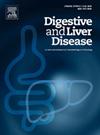Does the SCOPE (Sclerosing Cholangitis Outcomes in PEdiatrics) index effectively predict later liver transplantation in children with sclerosing cholangitis?
IF 3.8
3区 医学
Q1 GASTROENTEROLOGY & HEPATOLOGY
引用次数: 0
Abstract
Background & Aims
The SCOPE (Sclerosing Cholangitis Outcomes in Pediatrics) index was developed to provide the first pediatric prognostic score for primary sclerosing cholangitis (PSC), but its efficacy has yet to be confirmed. We aimed to assess its ability to predict liver transplantation (LT) over a 5-year follow-up.
Methods
We retrospectively included PSC-diagnosed patients under 18 years of age from two European tertiary-care centers. The SCOPE index was calculated at diagnosis and at 1, 3, and 5 years post-diagnosis. The ability of the SCOPE index to predict LT was assessed using multivariate Cox regression and ROC curve analysis.
Results
Sixty patients were included. In transplanted patients, the mean SCOPE index at diagnosis was similar to non-transplanted patients, but significantly higher at 1, 3, and 5 years post-diagnosis (p < 0.001, p = 0.009, p = 0.006, respectively). Patients with overlapping autoimmune hepatitis (AIH) had higher SCOPE at diagnosis (p = 0.005), but this difference diminished over time. The SCOPE index was a significant predictor of LT at various time points (HRs: 1.32 to 3.44) and showed good-to-excellent discriminative power (AUC 0.87 at diagnosis; 0.97 at 1 year).
Conclusions
The SCOPE index effectively predicts LT in pediatric PSC, with strong reliability over time. Coexisting AIH may affect score accuracy at diagnosis due to inflammation.
SCOPE(儿科硬化性胆管炎结局)指数能否有效预测硬化性胆管炎患儿的肝移植?
背景与目的:SCOPE(儿科硬化性胆管炎结局)指数是为了提供原发性硬化性胆管炎(PSC)的首个儿科预后评分而开发的,但其疗效尚未得到证实。我们的目的是评估其在5年随访期间预测肝移植(LT)的能力。方法:我们回顾性地纳入了来自两个欧洲三级保健中心的18岁以下psc诊断患者。SCOPE指数于诊断时及诊断后1、3、5年计算。SCOPE指数预测LT的能力采用多变量Cox回归和ROC曲线分析进行评估。结果:共纳入60例患者。在移植患者中,诊断时的平均SCOPE指数与未移植患者相似,但在诊断后1、3和5年显著高于未移植患者(p < 0.001, p = 0.009, p = 0.006)。重叠自身免疫性肝炎(AIH)患者在诊断时具有更高的SCOPE (p = 0.005),但随着时间的推移,这种差异逐渐减弱。SCOPE指数是不同时间点LT的显著预测因子(hr: 1.32 ~ 3.44),并显示出良好到优异的判别能力(诊断时AUC为0.87;1年0.97)。结论:SCOPE指数可有效预测小儿PSC的LT,且随时间推移具有较强的可靠性。同时存在AIH可能由于炎症影响诊断时评分的准确性。
本文章由计算机程序翻译,如有差异,请以英文原文为准。
求助全文
约1分钟内获得全文
求助全文
来源期刊

Digestive and Liver Disease
医学-胃肠肝病学
CiteScore
6.10
自引率
2.20%
发文量
632
审稿时长
19 days
期刊介绍:
Digestive and Liver Disease is an international journal of Gastroenterology and Hepatology. It is the official journal of Italian Association for the Study of the Liver (AISF); Italian Association for the Study of the Pancreas (AISP); Italian Association for Digestive Endoscopy (SIED); Italian Association for Hospital Gastroenterologists and Digestive Endoscopists (AIGO); Italian Society of Gastroenterology (SIGE); Italian Society of Pediatric Gastroenterology and Hepatology (SIGENP) and Italian Group for the Study of Inflammatory Bowel Disease (IG-IBD).
Digestive and Liver Disease publishes papers on basic and clinical research in the field of gastroenterology and hepatology.
Contributions consist of:
Original Papers
Correspondence to the Editor
Editorials, Reviews and Special Articles
Progress Reports
Image of the Month
Congress Proceedings
Symposia and Mini-symposia.
 求助内容:
求助内容: 应助结果提醒方式:
应助结果提醒方式:


